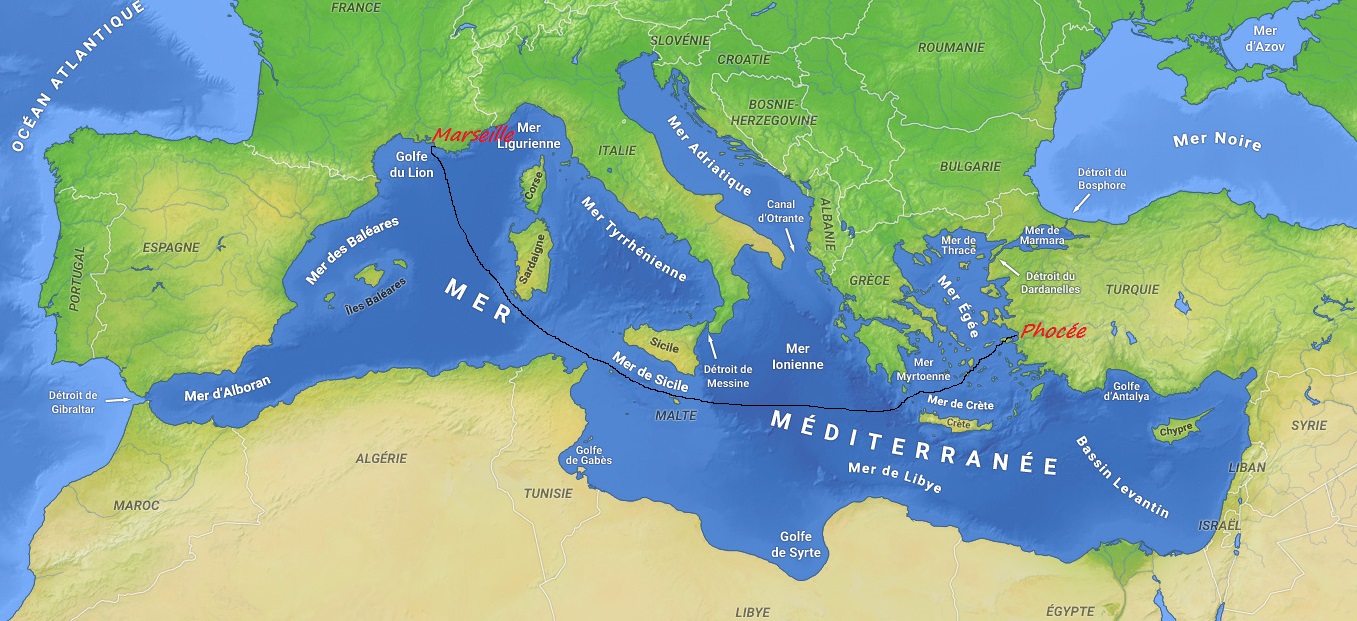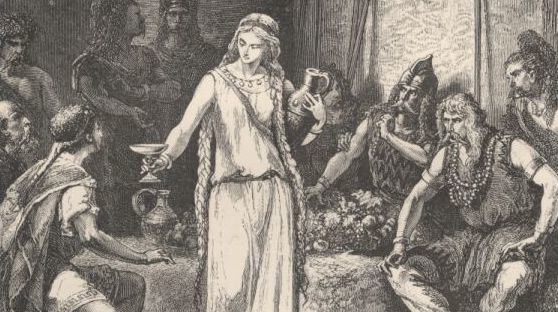Une histoire contée par Agathe Perrier et publiée dans
 |
La fondation de Marseille par les Phocéens La légende de Gyptis et Protis |
Marseille

|

|
|
Marseille est la plus ancienne ville de France, fondée en 600 avant Jésus-Christ par
les Grecs. Une histoire racontée dans le mythe fondateur de Gyptis et Protis, où la fille des autochtones tombe
sous le charme et épouse un marin originaire de Phocée.
Avant toute chose, il faut comprendre pourquoi ce Phocéen baptisé Protis est venu sur les terres gauloises. À l'époque, Phocée est une cité grecque qui se situe en Asie Mineure. Le territoire est trop étroit et peu fertile, aussi le peuple s'est-il tourné vers des activités maritimes telles que la pêche, le commerce et la piraterie. Une des explorations de la Méditerranée a amené à la découverte de la rade marseillaise. Les récits à propos de cet endroit sont si passionnés qu'il est décidé d'y envoyer deux navires de cinquante rameurs, commandés par Simos et le fameux Protis, afin d'y fonder une colonie. |
Marseille is the oldest city in France, founded in 600 BC by the Greeks.
A story told in the founding myth of Gyptis and Protis, where the native girl falls in love and marry a sailor from
Phocaea.
First of all, one must understand why this Phoenician named Protis came to the Gallic lands. At the time, Phocaea is a Greek city located in Asia Minor. The territory is too narrow and not very fertile, so the people have turned to maritime activities such as fishing, trade and piracy. One of the explorations of the Mediterranean led to the discovery of the harbor of Marseilles. The stories about this place are so passionate that it is decided to send two ships of fifty rowers, ordered by Simos and the famous Protis, in order to found a colony there. |
 |
|
Un mariage surprise Arrivés sur les lieux, les deux Phocéens tombent littéralement sous le charme, et notamment de la baie du Lacydon, l'actuel Vieux-Port. Ils sont accueillis par une population autochtone, les Ségobriges, une tribu celto-ligure. D'après les dires, les Sérobriges devaient être installés sur les hauteurs des collines d'Allauch d'où ils pouvaient voir arriver leurs ennemis, étant en conflit permanent avec les autres peuples de Gaule. Les Sérobriges ont pour roi un homme nommé Nannus. Ce dernier invite les deux Phocéens aux noces de sa fille, Gyptis, qui se tiennent le jour-même. D'après les traditions locales, la princesse choisit son futur époux le jour de son mariage, en lui apportant une coupe remplie d'eau au cours du repas. Contre toute attente, Gyptis n'a pas apporté la coupe à un de ses prétendants, mais au Grec Protis. Pour célébrer cette union, dans laquelle il y voit la volonté des Dieux, le roi Nannus autorise alors Protis et les Phocéens à fonder une ville, Massalia, sur la rive nord du Lacydon. |
A surprise wedding
Arrived at the scene, the two Phocaeans fall literally under the spell, and in particular of Lacydon Bay, the current Old Port. They are hosted by an indigenous population, the Segobriges, a Celto-Ligurian tribe. According to the statements, the Serobriges were to be installed on the heights of the hills of Allauch from where they could see arriving their enemies, being in permanent conflict with the other peoples of Gaul. The Serobriges have for king a man named Nannus. The latter invites the two Phoenicians to the wedding of his daughter, Gyptis, which are held the same day. According to local traditions, the princess chooses her future husband on the day of her wedding, by bringing her a cup filled with water during the meal. Against all odds, Gyptis did not bring the cup to one of his contenders, but to the Greek Protis. To celebrate this union, in which he sees the will of the Gods, King Nannus then authorizes Protis and the Phoenicians to found a city, Massalia, on the north shore of Lacydon. |
 |
|
Deux versions pour un seul mythe La légende de Gyptis et Protis est arrivée jusqu'à nous grâce à deux sources principales. Dans "La Constitution des Massaliotes", Aristote décrit cette histoire ainsi que Trogue Pompée dans "Histoires philippiques", texte perdu mais résumé par l'histoirien romain Justin. Les deux versions présentent quelques différences, notamment au niveau des noms des deux protagonistes. Si Trogue Pompée les appelle bien Gyptis et Protis, Artistote, lui, les nomme Petta et Euxène. Toutefois, le cours de l'histoire, à savoir le mariage tout à fait imprévu de la fille du roi avec un étranger, reste le même. |
Two versions for a single myth
The legend of Gyptis and Protis came to us thanks to two main sources. In "The Constitution of the Massaliotes", Aristotle describes this story as well as Trogue Pompey in "Histoires philippiques", a text lost but summarized by the Roman historian Justin. Both versions have some differences, especially in terms of the names of the two protagonists. If Trogue Pompey calls them Gyptis and Protis, Artistote calls them Petta and Euxene. However, the heart of the story, namely the quite unexpected marriage of the king's daughter with a stranger, remains the same. |
 |
|
Des traces des Grecs souvent retrouvées à Marseille Des traces du port originel de Marseille où les Phocéens auraient accosté sont aujourd'hui toujours visibles du côté du Vieux-Port. Elles ont été découvertes en 1967 à l'occasion de la construction du centre commercial le Centre Bourse. Un jardin des vestiges a même été créé pour les protéger et les exposer au public. On y trouve d'ailleurs également, et depuis 1983, le musée d'Histoire de Marseille. Plus récemment, du côté de la Corderie (7e), ce sont même des vestiges d'une ancienne carrière grecque de calcaire datant de -500 avant Jésus-Christ qui ont été découverts sur un chantier destiné à accueillir un projet immobilier. Depuis, les habitants se sont mobilisés pour y aménager, comme derrière le Vieux-Port, un jardin des vestiges. |
Traces of the Greeks often found in Marseille
Traces of the original port of Marseilles where the Phoceans would have docked today are still visible on the side of the Old Port. They were discovered in 1967 on the occasion of the construction of the Center Bourse shopping center. A garden of the remains has even been created to protect and expose them to the public. There is also also, and since 1983, the Museum of History of Marseille. More recently, on the side of the Corderie (13007), it is even remains of an old Greek quarry of limestone dating from -500 BC which were discovered on a site intended to accommodate a real estate project. Since then, residents have mobilized to develop, as behind the Old Port, a garden of remains. |



|